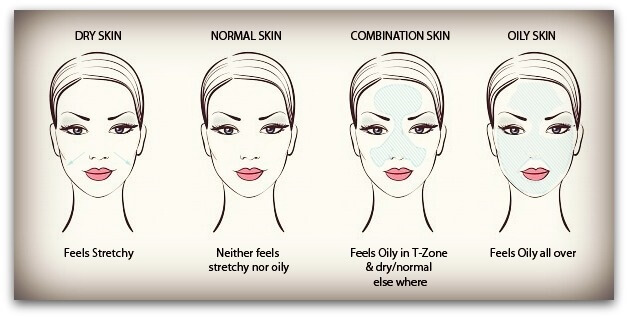Do you know? It is important to know your skin type to combat potential issues without causing more problems. Identify skin type so that you can begin to make informed decisions. The important question is How do I know my skin type? Obviously, you cannot treat any skin issue without identifying skin type. Scroll till the end to learn how do I know my skin type easily at home and take care of my skin with natural homemade tips to get glowing skin.
One should only get healthy, glowing, and flawless skin after determining the skin type. By knowing the type of skin you have, you can begin to care for and protect its needs now according to your skin type.
If you know your skin type you can choose the best skincare regime that caters to your specific needs. Wheater you use homemade or commercial skin-care products, it is important to know your skin type first. If you choose moisturizing products on your oily skin, you will suffer from acne breakout and greasiness. If you choose oil-free products on your skin or natural ingredients, you will suffer from extreme dryness, roughness, and flaking skin.
No matter what you choose, makeup products or skincare, you need to know your skin type to get clear and healthy skin.
In this post you’ll learn:
- Importance of knowing your skin type
- Types of skin
- How to know your skin type
- Skin-care routine (natural skin care)
- Daily skin care with natural ingredients
- Weekly skin care with natural ingredients
Importance Of Knowing Your Skin Type
It is important to know your skin type in choosing the right skin-care products according to your actual skin type. Using the wrong products can make the skin worse than improving. If you know your skin type you can choose the best skincare regime that caters to your specific needs. Treating the wrong skin type leads to acne breakout, irritation, or premature aging. No matter what you need, makeup or skincare products, you need to know your skin type first to get clear skin.
So here we go to know your skin type.
Types Of Skin
There are basically 5 types of skin:
- Oily skin
- Dry skin
- Combination skin
- Acne-prone skin
- Sensitive skin
What Is Oily Skin
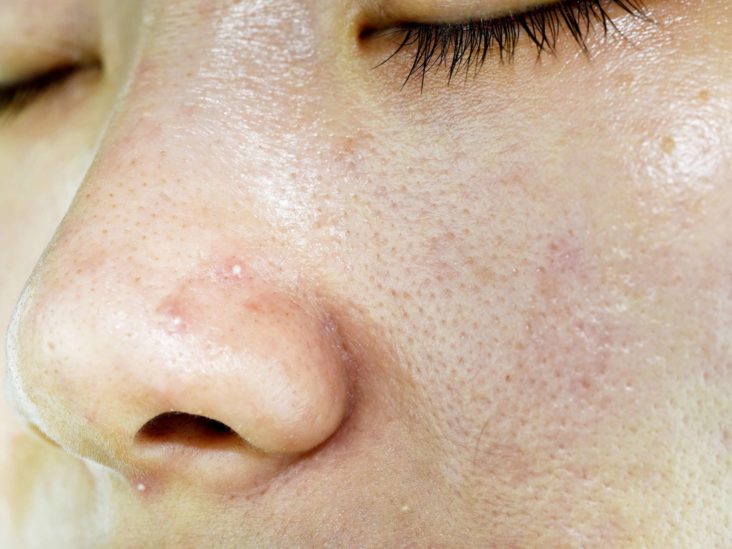
Oily skin happens when sebaceous glands overproduce sebum. Sebum is an oily waxy substance that hydrates the skin. Sebaceous glands are located under the skin.
Over-production of sebum leads to oily skin.
How To Identify Oily Skin
- Skin looks shiny.
- Oily greasy face after waking up in the morning.
- Makeup doesn’t stay on
- Clogged/blocked pores on the face.
- Feel greasy especially T-zone area (nose, chin, and forehead).
- Clogged pores lead to acne therefore you may suffer from a frequent acne breakouts.
- Pimples especially in the T-zone area.
- Visible pores on the nose.
What Is Dry Skin
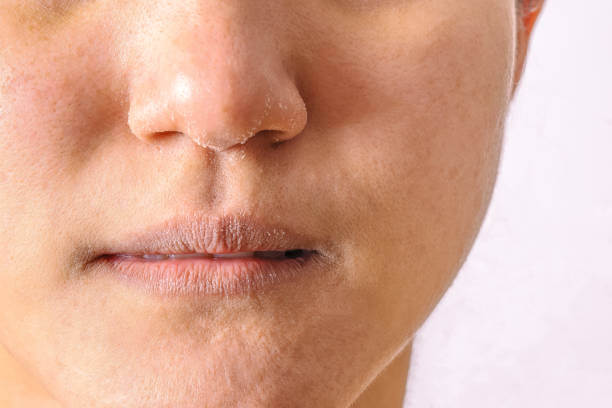
Dry skin happens when the skin does not get moisture and hydration. Because of less moisture, the skin gets dry and sometimes rough.
How To Know If My Skin Is Dry
- You may feel tightness after waking up in the morning.
- Skin become rough, flaky or even scaly after washing the face.
- Fine lines are visible.
- Skin texture is smooth.
- Less or no clogged/blocked pores.
- Pores are not visible.
What Is Combination Skin
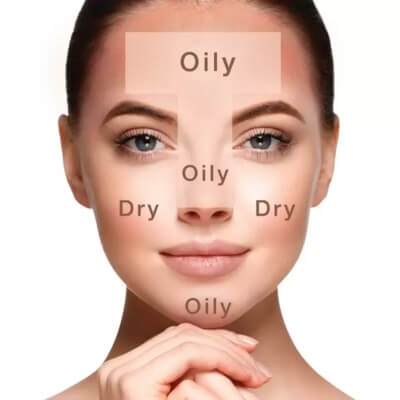
Combination skin happens when the T-zone area (nose, chin, forehead) is oily and the rest of the face is dry. People with combination skin are prone to clogged pores in the T-zone and feel dryness on the cheeks.
People with combination skin always have trouble figuring out what type of skin they have.
How To Know If My Skin Is a Combination
- You may feel greasiness in the T-zone area and dryness on the rest of the face after waking up in the morning.
- Clogged pores on the nose.
- Pores are likely visible on the nose.
What Is Acne-Prone Skin
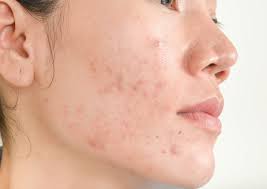
This skin type always or frequently gets acne breakouts. The pores of acne-prone skin tend to clog easily, making you more susceptible to whiteheads, blackheads, or pimples than other skin types.
You can have oily or dry skin and be prone to acne, most likely to have oily skin. Oily skin produces excessive oil leads to acne breakout.
How To Know If My Skin Is Acne-Prone
- Frequent acne breakouts all over the face that just never seem to go away.
- Clogged pores on the face.
- Blackheads and whiteheads on the chin and nose.
- Pores are visible on the face.
What Is Sensitive Skin
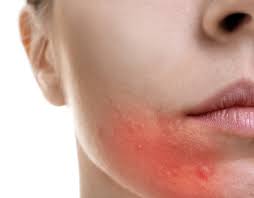
This skin type can be oily, dry, or in combination. If you notice the following symptoms frequently you’re your skin is sensitive:
- Itchiness after using certain fragrances.
- Frequent rashes
- Burning after using certain skin-care products
- Tingling effects.
- This skin type is prone to inflammation and irritation and can be caused by certain skin conditions such as eczema, rosacea, or allergies.
How To Know If My Skin Is Sensitive
- You may feel irritation or itchiness after makeup.
- Frequent rashes and bumps on the face.
- Negative reaction to fragrance.
How To Care For Your Skin
Have you determined your skin type? Now, you also need to know how to meet your skin type’s primary needs. Scroll till the end for skin-care tips and routines for all skin types so you can be better equipped to build a skincare routine that suits your skin.
Skin Care For Oily Skin Type:
- Below are daily and weekly skin-care steps to treat oily skin.
- Daily skin-care steps are:
- Cleansing | Toning | Moisturizing | Sunscreen
- Weekly skin-care steps:
- Exfoliate | Face Pack.
Daily Skin-Care Steps For Oily Skin
Cleansing for oily skin:
Wash your face twice a day with an oil-free cleanser.
DIY Cleanser For Oily Skin:
- Charcoal powder (2 tablespoons)
- Cinnamon powder (½ tablespoon)
- Turmeric powder (quarter teaspoon)
- Mix all the ingredients and store them in an air-tight jar.
- This will last long for 1-2 months at room temperature.
- Take a small amount of this powder and mix with water to mix.
- Wash your face with this twice daily.
Toning for oily skin:
Use a toner after washing your face.
Toner should be applied once or twice a day. It will help in reducing the pores of the skin.
DIY Toner For Oily Skin:
- Cucumber juice (4-5 tablespoons)
- Apple cider vinegar (½ tablespoon)
- Mix all the ingredients and store in a bottle.
- This will last long for 10 days at a refrigerator.
- Apply on your face after washing your face.
Moisturizing for oily skin:
Use moisturizer twice a day after toning the face.
Use a non-comedogenic lightweight moisturizer that won’t clog the pores of the skin.
DIY Moisturizer For Oily Skin:
- Aloe vera gel (3-4 tablespoons)
- Tea tree oil (few drops)
- Mix both ingredients and store them in a container.
- Fresh aloe vera gel can last long for 10 days in a refrigerator and it is very effective.
- Commercial aloe vera gel can last long for 2-3 months at room temperature.
- Apply on your face and massage for a few seconds.
- No need to wash your face.
Sunscreen:
Choose a sunscreen according to your skin type.
Apply on your face after moisturizing. If your sunscreen contains moisturizing properties, you can skip moisturizer.
Sunscreen protects the skin and prevents dark spots, pigmentation, and blemishes to form.
Weekly Skin-Care Steps For Oily Skin
Exfoliation for oily skin:
Scrub your face twice a week with a mild exfoliator.
Exfoliation helps to remove dead skin cells, excessive oil, and dirt from the pores of the skin that are stuck on the pores. Dead skin cells and excessive oil lead to acne breakout.
Exfoliation opens to closes/blocked pores therefore, using a toner is necessary after exfoliation. Toner helps to reduce the size of the pores.
DIY Exfoliation For Oily Skin:
- Rice powder (1 tablespoon)
- Clove powder (½ tablespoon)
- Honey to mix.
- Apply this to your face and gently rub your face in a circular motion for 2 minutes.
- Wash your face.
Face Pack for oily skin:
To get oil-free, clear, and spotless skin, a face pack is a good idea.
Apply face pack twice or thrice a week.
DIY Face Pack For Oily Skin:
- Fuller’s earth/bentonite clay or any mud mask (1 tablespoon)
- Sandalwood powder (1 teaspoon)
- Licorice powder (1 teaspoon)
- Lemon juice (1 teaspoon)
- Mix with tomato or potato juice.
- Apply on your face properly.
- Leave it for 20-25 minutes.
- Wash it off.
Skin Care For Dry Skin Type:
- Below are daily and weekly skin-care steps to treat dry skin.
- Daily skin-care steps are:
- Cleansing | Toning | Moisturizing | Sunscreen
- Weekly skin-care steps:
- Exfoliate | Face Pack.
Daily Skin-Care Steps For Dry Skin
Cleansing for dry skin:
Wash your face twice a day with an oil-free cleanser.
DIY Cleanser For Dry Skin:
- Gram flour (2 tablespoons)
- Coffee powder (1 tablespoon)
- Turmeric powder (quarter teaspoon)
- Mix all the ingredients and store them in an air-tight jar.
- This will last long for 1-2 months at room temperature.
- Take a small amount of this powder and mix with water to mix.
- Wash your face with this twice daily.
Toning for dry skin:
Use a toner after washing your face.
Toner should be applied once a day. It will help in reducing the pores of the skin.
DIY Toner For Dry Skin:
- Cucumber juice (4-5 tablespoons)
- Glycerin (1 teaspoon)
- Vitamin e oil (if the skin is flaked and rough)
- Mix all the ingredients and store in a bottle.
- This will last long for 10 days at a refrigerator.
- Apply on your face after washing your face.
Moisturizing for dry skin:
Use moisturizer twice a day or as per need.
Use a good hydrating moisturizer.
DIY Moisturizer For dry Skin:
- Shea butter/cocoa butter (2 tablespoons)
- Almond oil (1 teaspoon)
- This can be stored for a long time at room temperature.
- Apply on your face.
- No need to wash.
Sunscreen:
Choose a sunscreen according to your skin type.
Sunscreen protects the skin and prevents dark spots, pigmentation, and blemishes to form.
Weekly Skin-Care Steps For Dry Skin
Exfoliation for dry skin:
Scrub your face once a week with a mild exfoliator.
Exfoliation helps to remove dead skin cells, excessive oil, and dirt from the pores of the skin that are stuck on the pores. Dead skin cells and excessive oil lead to acne breakout.
Exfoliation opens to closes/blocked pores therefore, using a toner is necessary after exfoliation. Toner helps to reduce the size of the pores.
DIY Exfoliation For Dry Skin:
- Rice powder (1 tablespoon)
- Almond powder (1 teaspoon)
- Curd to mix.
- Apply this to your face and gently rub your face in a circular motion for 2 minutes.
- Wash your face.
Face Pack for dry skin:
Using a nourishing and hydrating face pack makes the skin smooth, soft, and spotless.
Apply face pack twice a week.
DIY Face Pack For Dry Skin:
- Banana puree (2 tablespoons)
- Tomato juice (1 tablespoon)
- Licorice/sandalwood powder (1 tablespoon)
- Apply on your face properly.
- Leave it for 20-25 minutes.
- Wash it off.
Skin Care For Combination Skin Type:
- Below are daily and weekly skin-care steps to treat combination skin.
- Daily skin-care steps are:
- Cleansing | Toning | Moisturizing | Sunscreen
- Weekly skin-care steps:
- Exfoliate | Face Pack.
Daily Skin-Care Steps For Combination Skin
Cleansing for combination skin:
Wash your face twice a day with a cleanser.
DIY Cleanser For Combination Skin:
- Oats (2 tablespoons)
- Flaxseeds powder (1 tablespoon)
- Turmeric powder (quarter teaspoon)
- Mix all the ingredients and store them in an air-tight jar.
- This will last long for 1-2 months at room temperature.
- Take a small amount of this powder and mix with water to mix.
- Wash your face with this twice daily.
Toning for combination skin:
Use a toner after washing your face.
Toner should be applied once or twice a day. It will help in reducing the pores of the skin.
DIY Toner For Combination Skin:
- Cucumber juice (4-5 tablespoons)
- Apple cider vinegar (½ tablespoon)
- Glycerin (quarter teaspoon)
- Mix all the ingredients and store in a bottle.
- This will last long for 10 days at a refrigerator.
- Apply on your face after washing your face.
Moisturizing for combination skin:
Use moisturizer twice a day after toning the face.
Use a pea-sized moisturizer to moisturize your skin. Reapply on your cheeks if necessary.
DIY Moisturizer For Combination Skin:
- Aloe vera gel (3-4 tablespoons)
- Sweet almond oil (a few drops)
- Mix both ingredients and store them in a container.
- Fresh aloe vera gel can last long for 10 days in a refrigerator and it is very effective.
- Commercial aloe vera gel can last long for 2-3 months at room temperature.
Sunscreen:
Choose a sunscreen according to your skin type.
Apply on your face after moisturizing. If your sunscreen contains moisturizing properties, you can skip moisturizer.
Sunscreen protects the skin and prevents dark spots, pigmentation, and blemishes to form.
Weekly Skin-Care Steps For Combination Skin
Exfoliation for combination skin:
Scrub your face twice a day with a mild exfoliator.
Exfoliation helps to remove dead skin cells, excessive oil, and dirt from the pores of the skin that are stuck on the pores. Dead skin cells and excessive oil lead to acne breakout.
Exfoliation opens to closes/blocked pores therefore, using a toner is necessary after exfoliation. Toner helps to reduce the size of the pores.
DIY Exfoliation For Combination Skin:
- Rice powder (1 tablespoon)
- Clove powder (½ tablespoon)
- Honey to mix.
- Apply this to your face and gently rub your face in a circular motion for 2 minutes.
- Wash your face.
Face Pack for combination skin:
For combination skin types,
DIY Face Pack For Combination Skin:
- Papaya puree (1 tablespoon)
- Sandalwood powder (1 teaspoon)
- Curd (1 tablespoon)
- Apply on your face properly.
- Leave it for 20-25 minutes.
- Wash it off.
Skin Care For Acne-Prone Skin Type:
- Below are daily and weekly skin-care steps to treat acne-prone skin.
- Daily skin-care steps are:
- Cleansing | Toning | Moisturizing | Sunscreen
- Weekly skin-care steps:
- Exfoliate | Face Pack.
Daily Skin-Care Steps For Acne-Prone Skin
Cleansing for acne-prone skin:
Wash your face twice a day with an oil-free cleanser.
DIY Cleanser For Acne-prone skin:
- Charcoal powder (2 tablespoons)
- Cinnamon powder (½ tablespoon)
- Turmeric powder (quarter teaspoon)
- Mix all the ingredients and store them in an air-tight jar.
- This will last long for 1-2 months at room temperature.
- Take a small amount of this powder and mix with water to mix.
- Wash your face with this twice daily.
Toning for acne-prone skin:
Use a toner after washing your face.
Toner should be applied once or twice a day. It will help in reducing the pores of the skin.
10 DIY Toner for all skin types
DIY Toner For Acne Prone Skin:
- Cucumber juice (4-5 tablespoons)
- Apple cider vinegar (½ tablespoon)
- Mix all the ingredients and store them in a bottle.
- This will last long for 10 days in a refrigerator.
- Apply on your face after washing your face.
Moisturizing for acne-prone skin:
Use moisturizer twice a day after toning the face.
Use a non-comedogenic lightweight moisturizer that won’t clog the pores of the skin.
DIY Moisturizer For Acne-Prone Skin:
- Aloe vera gel (3-4 tablespoons)
- Tea tree oil (few drops)
- Clove powder (1 pinch)
- Mix both ingredients and store them in a container.
- Fresh aloe vera gel can last long for 10 days in a refrigerator and it is very effective.
- Commercial aloe vera gel can last long for 2-3 months at room temperature.
Sunscreen:
Choose a sunscreen according to your skin type. It should be only for acne-prone skin.
Apply on your face after moisturizing. If your sunscreen contains moisturizing properties, you can skip moisturizer.
Sunscreen protects the skin and prevents dark spots, pigmentation, and blemishes to form.
Weekly Skin-Care Steps For Acne-Prone Skin
Exfoliation for acne-prone skin:
Scrub your face twice a day with a mild exfoliator.
Exfoliation helps to remove dead skin cells, excessive oil, and dirt from the pores of the skin that are stuck on the pores. Dead skin cells and excessive oil lead to acne breakout.
Exfoliation opens to closes/blocked pores therefore, using a toner is necessary after exfoliation. Toner helps to reduce the size of the pores.
DIY Exfoliation For Acne-Prone Skin:
- Neem powder (1 tablespoon)
- Clove powder (½ tablespoon)
- Honey to mix.
- Apply this to your face and gently rub your face in a circular motion for 2 minutes.
- Wash your face.
Face Pack for acne-prone skin:
To get oil-free, clear, and spotless skin, a face pack is a good idea.
Apply face pack twice or thrice a week.
DIY Face Pack For Acne-prone Skin:
- Fuller’s earth/bentonite clay or any mud mask (1 tablespoon)
- Neem powder (1 teaspoon)
- Licorice powder (1 teaspoon)
- Lemon juice (1 teaspoon)
- Apply on your face properly.
- Leave it for 20-25 minutes.
- Wash it off.
Skin Care For Sensitive Skin Type:
- Below are daily and weekly skin-care steps to treat sensitive skin.
- Daily skin-care steps are:
- Cleansing | Toning | Moisturizing | Sunscreen
- Weekly skin-care steps:
- Exfoliate | Face Pack.
Daily Skin-Care Steps For Sensitive Skin
Cleansing for sensitive skin:
Wash your face twice a day with a mild cleanser.
DIY Cleanser For Sensitive Skin:
- Oats (2 tablespoons)
- Gram flour (1 tablespoon)
- Turmeric powder (quarter teaspoon)
- Mix all the ingredients and store them in an air-tight jar.
- This will last long for 1-2 months at room temperature.
- Take a small amount of this powder and mix with water to mix.
- Wash your face with this twice daily.
Toning for sensitive skin:
Use a toner after washing your face.
DIY Toner For Sensitive Skin:
- Cucumber juice (4-5 tablespoons)
- Rose water (2 tablespoons)
- Glycerin (a few drops)
- Mix all the ingredients and store them in a bottle.
- This will last long for 10 days in a refrigerator.
- Apply on your face after washing your face.
Moisturizing for sensitive skin:
Use moisturizer twice a day after toning the face.
DIY Moisturizer For Sensitive Skin:
- Aloe vera gel (3-4 tablespoons)
- Almond oil (1 teaspoon)
- Mix both ingredients and store them in a container.
- Fresh aloe vera gel can last long for 10 days in a refrigerator and it is very effective.
- Commercial aloe vera gel can last long for 2-3 months at room temperature.
Sunscreen:
Choose a sunscreen according to your skin type.
Apply on your face after moisturizing. If your sunscreen contains moisturizing properties, you can skip moisturizer.
Sunscreen protects the skin and prevents dark spots, pigmentation, and blemishes to form.
Weekly Skin-Care Steps For Sensitive Skin
Exfoliation for sensitive skin:
Scrub your face twice a day with a mild exfoliator.
Exfoliation helps to remove dead skin cells, excessive oil, and dirt from the pores of the skin that are stuck on the pores. Dead skin cells and excessive oil lead to acne breakout.
Exfoliation opens to closes/blocked pores therefore, using a toner is necessary after exfoliation. Toner helps to reduce the size of the pores.
DIY Exfoliation For Sensitive Skin:
- Orange peel powder/rose petals powder (2 tablespoons)
- Coffee powder (½ tablespoon)
- Honey to mix.
- Apply this to your face and gently rub your face in a circular motion for 2 minutes.
- Wash your face.
Face Pack for sensitive skin:
Apply face pack once or twice a week as per need.
DIY Face Pack For Sensitive Skin:
- Papaya puree (2 tablespoons)
- Sandalwood powder (1 tablespoon)
- Mix with tomato juice.
- Apply on your face properly.
- Leave it for 20 minutes.
- Wash it off.
Managing sensitive skin can be challenging, as it takes considerable time and effort. It is very important to determine which ingredients cause inflammation, and irritation and which are suitable. To make it easier, use only one remedy or product at a time. This rule applies to both skincare and cosmetics.


